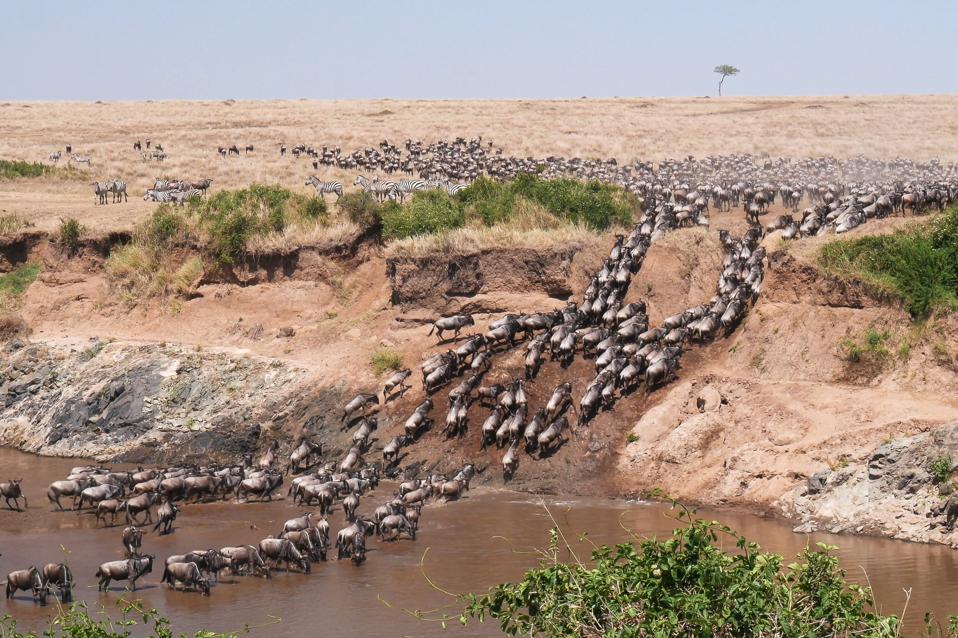On July 21, a footage of dozens of safari vehicles blocking wildebeest during the Great Migration in Serengeti ignited public outrage. It also raised questions about the safety of both the animals and the travelers, as well as the responsibility of tour operators, guides and visitors alike.
The viral video may have faded from social media feeds, but the conversation it sparked about overtourism in East Africa’s national parks, especially in Serengeti, is far from over.
“Sadly, it was not a new situation. This has been building up for years,” said Nick Kleer, a wildlife guide who posted the viral video on Instagram, in a video interview. “But I did not think this video would spread that widely when I posted it. However, I am glad it did, because people started having conversations about it,” he added.
So, who is responsible when tourism goes too far?
Is it the guides and tour operators who chase wildlife so that travelers can have the perfect photo? Or the park authorities who fail to enforce regulations or limit vehicle numbers during peak season?
Or is it travel marketing fueling high-season demand without educating travelers about responsible behavior? Perhaps, it is the travelers themselves who expect dramatic and close encounters without understanding the cost.
Framing The Migration All Wrong
The Great Migration is often promoted as “the world’s greatest wildlife spectacle,” framing the migration as a must-see, once-in-a-lifetime event.
Tour operators, travel media, and social platforms frequently showcase only the peak moments, usually how wildebeests are plunging into the river where crocodiles are waiting to hunt them.
The focus is on a few high-drama weeks that now fuel an overwhelming demand for a narrow time window of July and August, while overshadowing the quieter, equally remarkable movements that happen year-round across the Serengeti and Maasai Mara ecosystems.
In response to the viral video, Tim Henshall, head of tourism marketing for Tanzania Tourism in the United Kingdom, emphasized in an official statement that “The Great Migration is a 12-month-long spectacle, not a six-week scramble.” He also sees a need to communicate this message more clearly.
The Danger Of Overpromising Wildlife Encounters
“I see the Kogatende incident as a predictable outcome of poorly designed tourism systems rather than isolated bad behaviour,” says David Ermen, sustainable tourism expert, trainer for the Global Sustainable Tourism Council and managing director of Destination Capacity.
“The industry has systematically created unrealistic tourist expectations, like a “Big Five guarantee,” while failing to train operators and guides as educators and enforce sustainable practices properly. This creates a classic commons dilemma where short-term revenue maximalization destroys the very resource everyone depends on,” he added.
So why is it dangerous when travel marketing overpromises?
“A zoo is the only place that should guarantee sightings; you simply cannot guarantee that in the wild,” he said. However, when marketing focuses more on outcomes than the overall experience, it creates unrealistic expectations and leaves the guides and tour operators to meet those high expectations, even if they have to jeopardize the safety of both animals and visitors, or risk guest dissatisfaction and negative reviews.
Ermen believes that tour operators and travel companies should shift their mindset from (over)promising specific sightings to focusing on the experience of simply being there or narratives around conservation. “Outcome-driven tourists may look elsewhere, but this approach will attract those who value connections over checklists and visit the location responsibly,” Ermen said.
Industry Insiders Say The Marketing Needs A Reset
The viral footage was difficult to watch for many in the industry, including Lydia Eva Mpanga, founder of Nkuringo Safaris, not just because of what it showed, but because of what it revealed.
For Mpanga, the disruption of the Great Migration felt deeply personal. She described it as a sacred rhythm of nature, and how frightening it is that human interference can easily disrupt it.
The incident, she said, underscores the pressure some guides face to deliver dramatic sightings at any cost. “We need to empower guides to say ‘no’ when behavior risks the wildlife, and we need guests to understand that a true safari is about connection, not interference,” she said.
Maija de Rijk-Uys, managing director of Go2Africa, views the issue not in the sheer number of travelers visiting Tanzania, but in the concentration of vehicles in the same place at the same time. “Most national parks don’t face this pressure,” she said. “It’s the northern Serengeti during peak season that feels the strain.”
She advocates for promoting lesser-visited parks, such as Ruaha, Nyerere (Selous), and Rubondo, and for encouraging broader regional travel to ease pressure on congested areas during peak seasons.
Wildebeest also roam Kenya’s Loita Hills nearly year-round, while Zambia’s Liuwa Plains host a smaller, seasonal migration that peaks in late November. In Botswana, zebra herds follow ancient routes between the Okavango Delta, Makgadikgadi Pans, and Nxai Pan from November to April. These lesser-known spectacles were recommended by Jamie Mehrotra and Pearl Jurist Schoen of Extraordinary Journeys when asked about the alternatives to Great Migration in this Forbes article.
As tourism to East Africa continues to grow, so does the responsibility to travel consciously. Are we, as travelers, willing to accept uncertainty in exchange for authenticity? And how can the industry shift from spectacle-driven marketing to experiences that respect the delicate balance between wildlife, local communities, and conservation?

